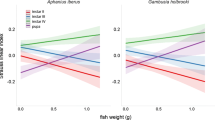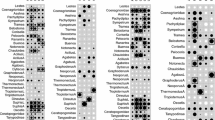Abstract
The individual and interactive effects of mosquitofish (Gambusia affinis Baird and Girard) and green sunfish (Lepomis cyanellus Rafinesque) populations on densities of mosquito immatures and other aquatic fauna were assessed in experimental rice plots over a 12 week period. Mosquitofish, stocked at a much higher rate (2318 per ha) than is usually used in commercial rice fields, increased 88-fold in numbers per minnow trap over a ten week period. Adult green sunfish (7–10 cm TL), stocked at the same rate as mosquitofish, reproduced in the rice plots, but reproductive success was strongly associated with plot depth. Mosquitofish numbers were significantly lower in plots stocked with green sunfish early in the season but this difference soon disappeared.
Significant reductions in densities of the immature stages of the mosquito, Culex tarsalis Coquillet, by the fishes were not demonstrated by analyses of variance and covariance (mosquitofish may have provided some control during the very last week [Blaustein, 1990]). Populations of the mosquito, Anopheles freeborni Aitken, were not significantly reduced by mosquitofish except during the last week. A. freeborni populations were significantly higher in the green sunfish treatment than in the control and mosquitofish treatment.
Numbers of notonectids (predators of mosquitoes) were depressed in all fish treatments. This may have indirectly contributed to the ineffectiveness of the fishes to control mosquitoes. Other invertebrate predators of mosquitoes were not reduced significantly by the fishes. Similarly, these fishes had little effect on microcrustaceans and chironomids. These fauna, by serving as alternative prey, may have reduced predation intensity on mosquitoes.
These results demonstrate that high stocking rates and high population growth of mosquitofish will not necessarily provide control of mosquitoes in rice fields.
Similar content being viewed by others
References
Ahmed, W., R. K. Washino & P. A. Gieke, 1970. Further biological and chemical studies on Gambusia affinis (Baird & Girard) in California. Proc. Calif. Mosq. Control Assoc. 38: 95–97.
Angerilli, N. P. D., 1980. Notes on some effects of simulated aquatic plants on predation on mosquito larvae by the fat-head minnow. Mosq. News 40: 652–654.
Bence, J. R., 1982. Some interactions of predaceous insects and mosquitofish (Gambusia affinis): a review of some recent results. Bull. Soc. Vector Ecol. 7: 41–44.
Bence, J., 1985. Behavioral responses of predators to prey abundance: Learning and population dynamic consequences. Bull. Ecol. Soc. Amer. 66: 140.
Bence, J., 1988. Indirect effects and biological control of mosquitoes by mosquitofish. J. appl. Ecol. 25: 505–521.
Bence, J. & W. W. Murdoch, 1982. Ecological studies of insect predators and Gambusia in rice fields: a preliminary report. Proc. Calif. Mosq. Vector Control Assoc. 50: 48–49.
Bence, J. & W. W. Murdoch, 1986. Prey size selection by the mosquitofish: Relation to optimal diet theory. Ecology 67: 324–326.
Blaustein, L., 1988a. Effects of vegetation, mosquitofish (Gambusia affinis) and green sunfish (Lepomis cyanellus) and their interactions on mosquitoes and other fauna in rice field enclosures. In: Biological interactions in rice fields: A community ecology approach to mosquito control. Ph.D. dissertation. University of California, Davis.
Blaustein, L., 1988b. Negative interactions between two predatory fishes in rice fields: Relevance to biological control. In: Biological interactions in rice fields: A community ecology approach to mosquito control. Ph.D. dissertation. University of California, Davis.
Blaustein, L., 1989a. Effects of various factors to sample mosquitofish (Gambusia affinis) and green sunfish (Lepomis cyanellus) populations in rice fields. J. amer. Mosq. Control. Assoc. 5: 29–35.
Blaustein, L., 1989b. Spatial distributions of Anopheles freeborni, Gambusia affinis and Lepomis cyanellus within experimental rice plots. J. amer. Mosq. Control Assoc. 5: 254–257.
Blaustein, L., 1990. Evidence for predatory flatworms as organizers of zooplankton and mosquito community structure in rice fields. Hydrobiologia 199: 179–191.
Blaustein, L. & H. Dumont, 1990. Typhloplanid flatworms (Mesostoma and related genera): Mechanisms of predation and evidence that they structure aquatic invertebrate communities. Hydrobiologia 198: 61–77.
Blaustein, L. & R. Karban, 1990. An indirect effect of the mosquitofish, Gambusia affinis, on the mosquito, Culex tarsalis. Limnol. Oceanogr. 35: 767–771.
Case, T. J. & R. K. Washino, 1979. Flatworm control of mosquito larvae in rice fields. Science 206: 1412–1414.
Cech, J. J., Jr. & A. L. Linden, 1987. Comparative larvivorous performances of mosquitofish, Gambusia affinis, and juvenile Sacramento blackfish, Orthodon microleptidotus, in experimental rice paddies. J. amer. Mosq. Control Assoc. 3: 35–41.
Coykendall, R. L., 1977. Aquacultural studies of mosquitofish, Gambusia affinis, in earthern impoundments: Stocking rate optimization for yield, protection of overwintering fish stocks. Proc. Calif. Mosq. Vector Control Assoc. 45: 80–82.
Danielsen, T. L., 1968. Differential predation on Culex pipiens and Anopheles albimanus mosquito larvae by two species of fish (Gambusia affinis and Cyprinodon nevadensis) and the effects of simulated reeds on predation. Ph.D. dissertation, University of California, Riverside.
Davey, R. B. & M. V. Meisch, 1977. Control of dark rice field mosquito larvae Psorophora columbiae by mosquitofish, Gambusia affinis and green sunfish, Lepomis cyanellus, in Arkansas rice fields. Mosq. News 37: 258–262.
Davey, R. B., M. V. Meisch, D. L. Gray, J. M. Martin, K. E. Sneed & F. J. Williams, 1974. Various fish species as biological control agents for the dark rice field mosquito in Arkansas rice fields. Envir. Entomol. 3: 823–826.
Farley, D. G., 1980. Prey selection by the mosquitofish Gambusia affinis in Fresno County rice fields. Proc. Calif. Mosq. Vector Control Assoc. 48: 55–51.
Farley, D. G. & L. C. Younce, 1977a. Stocking date versus efficacy of Gambusia affinis in Fresno County rice fields. Proc. Calif. Mosq. Vector Control Assoc. 45: 83–86.
Farley, D. G. & L. C. Younce, 1977b. Effects of Gambusia affinis on selected non-target organisms in Fresno County rice fields. Proc. Calif. Mosq. Vector Control Assoc. 45: 87–94.
Farley, D. G. & L. C. Younce, 1978. Diel and seasonal variations in the movements of Gambusia affinis in Fresno County rice fields. Proc. Calif. Mosq. Vector Control assoc. 46: 94–98.
Gall, G., J. J. Cech, Jr., V. Resh & R. K. Washino, 1980. Mosquitofish — an established predator. Calif. Agric. 34: 21–22.
Garcia, R. & B. Des Rochers, 1985. Studies of the development of an integrated mosquito control strategy for the Fall River Mills Area. Proc. Calif. Mosq. Vector Control Assoc. 53: 57–62.
Harwood, R. F. & M. T. James, 1979. Entomology in human and animal health. MacMillan Publ., New York.
Hess, A. D. & C. M. Tarzwell, 1942. The feeding habits of Gambusia affinis affinis, with special reference to the malaria mosquito, Anopheles quadrimaculatus. Am. J. Hygiene 35: 142–151.
Hoy, J. B. & D. E. Reed, 1970. Biological control of Culex tarsalis in a California rice field. Mosq. News 30: 222–230.
Hoy, J. B. & D. E. Reed, 1971. The efficacy of mosquitofish for control of Culex tarsalis in California rice fields. Mosq. News 31: 567–572.
Hoy, J. B., E. E. Kauffman & A. G. O'Berg, 1972. A large scale field test of Gambusia affinis and Chlorpyriphos for mosquito control. Mosq. News 32: 161–171.
Hoy, J. B., A. G. O'Berg & E. E. Kauffman, 1971. The mosquitofish as a biological control agent against Culex tarsalis and Anopheles freeborni in Sacramento Valley rice fields. Mosq. News 31: 146–152.
Huffaker, C. P., F. J. Simmonds & J. E. Lang, 1976. The theoretical and empirical basis of biological control. In: Huffaker, C. P. & P. S. Messenger (eds.). Theory and practice of biological control. Academic Press, New York. pp. 41–78.
Hurlbert, S. H., J. Zedler & D. Fairbanks, 1972. Ecosystem alteration by mosquitofish (Gambusia) predation. Science 175: 639–641.
Hurlbert, S. H. & M. S. Mulla, 1981. Impact of mosquitofish (Gambusia affinis) predation on plankton communities. Hydrobiologia 83: 125–151.
Huynh, H. & L. S. Feldt, 1976. Estimation of the Box correction for degrees of freedom from sample data in the randomized block and split-plot designs. J. Educational Studies 1: 69–82.
Kramer, V. L., R. Garcia & A. E. Colwell, 1987. An evaluation of the mosquitofish, Gambusia affinis, and the inland silverside, Menidia beryllina, as mosquito control agents in California wild rice fields. J. am. Mosq. Control. Assoc. 3: 626–632.
Mogi, M., I. Miyagi & B. D. Cabrera, 1984. Development and survival of immature mosquitoes (Diptera: Culicidae) in Phillipine rice fields. J. Med. Entomol. 21: 283–291.
Mogi, M., A. Mori & Y. Wada, 1980. Survival rates of immature stages of Culex tritaeniorhynchus (Diptera:Culicidae) in rice fields under summer cultivation. Trop. Med. 22: 111–126.
Moyle, P. B., 1976. Inland fishes of California. University of California Press, Berkeley. 405 pp.
Murdoch, W. W., J. Chesson & P. L. Chesson, 1985. Biological control in theory and practice. Am. Nat. 125: 324–366.
Service, W. M., 1976. Mosquito ecology: Field sampling methods. Wiley & Sons, New York.
Service, W. M., 1977. Mortalities of the immature stages of species B of the Anopheles gambiae complex in Kenya: Comparison between rice fields and temporary pools, identification of predators, and effects of insecticidal spraying. J. Med. Entomol. 13P: 535–545.
Toft, C. A. & P. Shea, 1983. Detecting community-wide patterns: Estimating power strengthens statistical inference. Am. Nat. 122: 618–625.
Washino, R. K. & Y. Hokama, 1967. Preliminary report on the feeding pattern of two species of fish in a rice habitat. Proc. Calif. Mosq. Control Assoc. 35: 687–713.
Washino, R. K. & Y. Hokama, 1968. Quantitative sampling of aquatic insects in a shallow-water habitat. Ann. Ent. Soc. Amer. 61–785–786.
Wurtsbaugh, W., J. J. Cech, Jr. & J. Compton, 1980. Effects of fish size on prey size selection in Gambusia affinis. Proc. Calif. Mosq. Vector Control Assoc. 48: 48–50.
Zalom, F. G. & A. A. Grigarick, 1980. Predation by Hydrophilus triangularis and Tropisternus lateralis in California rice fields. Ann. Entomol. Soc. Am. 73: 167–171.
Zaret, T., 1980. Predation in freshwater communities. Yale University Press, New Haven.
Author information
Authors and Affiliations
Rights and permissions
About this article
Cite this article
Blaustein, L. Larvivorous fishes fail to control mosquitoes in experimental rice plots. Hydrobiologia 232, 219–232 (1992). https://doi.org/10.1007/BF00013707
Received:
Revised:
Accepted:
Issue Date:
DOI: https://doi.org/10.1007/BF00013707




